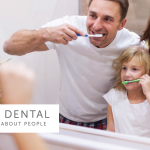Suffering from a headache may be reason enough to visit your dentist. Your mouth is part of your head, and as such many oral conditions can cause a headache.
Grinding, Clenching, and Bruxism
Grinding your teeth and clenching your jaw together on a regular basis can act as a trigger for headaches. Many people are unaware that they grind their teeth because grinding often occurs during sleep.
There is a simple solution for night grinding: a night guard. This is a simple device that you put on before going to bed. It protects your teeth, and improves the position of your jaws. Night guards keep muscles more relaxed thus preventing headaches.
It is important to have your dentist fit a night guard and not buy store-ready one, especially if you suffer from headaches. A night guard fitted by a dentist is made in a special laboratory from an impression of your unique mouth, and is of a higher quality and superior fit.
Furthermore, did you know that there are 9 designs of night guard? The proper design has to be selected by your dentist to fit the problem you have.
Unadjusted Bite
Teeth are meant to chew against one another, and fit like very well designed gears. When teeth don’t fit ideally, and one or more teeth grind sharper or harder than another, the effects to the teeth themselves as well as to your muscles and joints are harmful.
Unadjusted bite can be caused by all sorts of reasons from earlier dental treatment (such as high restoration or unfit crowns), elevation of teeth (inflammation in the root), to cysts or cracked teeth. Overeruption and overlying of teeth that occurs during life can also cause unadjusted bite.
Your dentist starts by diagnosing that a problem exists by conducting a comprehensive examination, including x-rays. Next, once the cause is identified, we move to treatment. If bite is an issue, your dentist can adjust it by marking teeth with indicator tape and moving your mouth in different directions to simulate jaw movement. The dentist uses these markings to identify problematic teeth, which will then be re-shaped.
This process prevents future wear of teeth, and protects and strengthens them. It does not hurt, though it may take a number of visits to get the bite exactly right.
Temporomandibular Problems
The temporomandibular joint is the joint that connects your jaw to your skull. When this joint is injured or damaged, it can lead to a localized pain or headache. To identify a problem with this joint, your dentist feels your jaw as you open and close your mouth, observes the range of motion, presses on areas around your jaw to identify sites of pain or discomfort and may take some x-rays.
Your dentist may be able to identify the cause of the problem with this joint, such as teeth grinding or unadjusted bite, and treat it. Sometimes when the cause cannot be determined, your dentist may determine that you will benefit from a mouth guard or physical therapy.
Impacted and Erupting Wisdom Teeth
An impacted tooth remains stuck in gum tissue or bone for various reasons. Impacted wisdom teeth are very common. They are often painless and do not cause problems. However, in some cases they may cause a misalignment of the bite by pushing, and this may cause unadjusted bite.
Studies estimate that up to 70% of all headaches occur from muscle tension related to your bite. If you have recurrent or chronic headaches, do not forget to visit your dentist!






